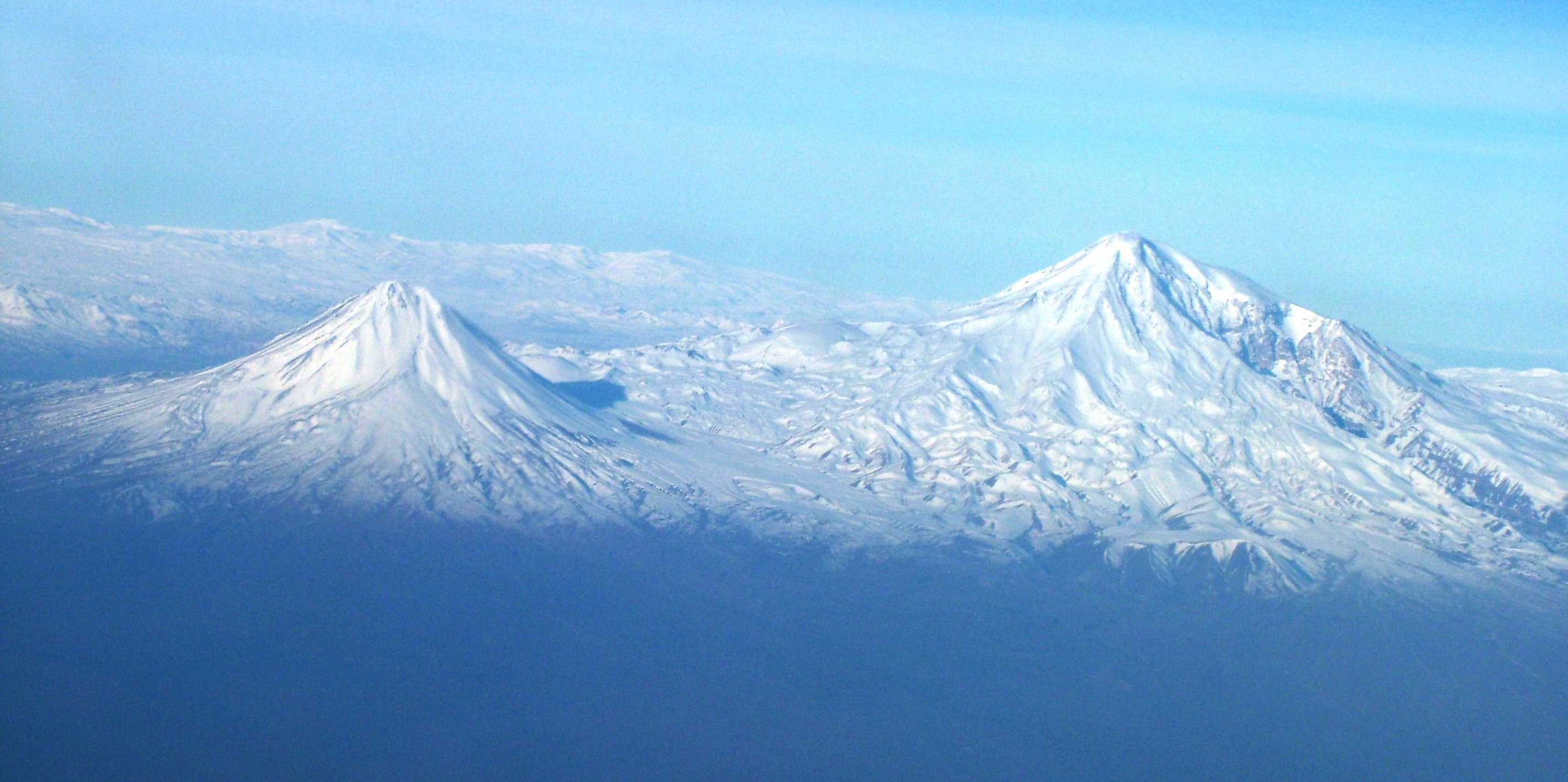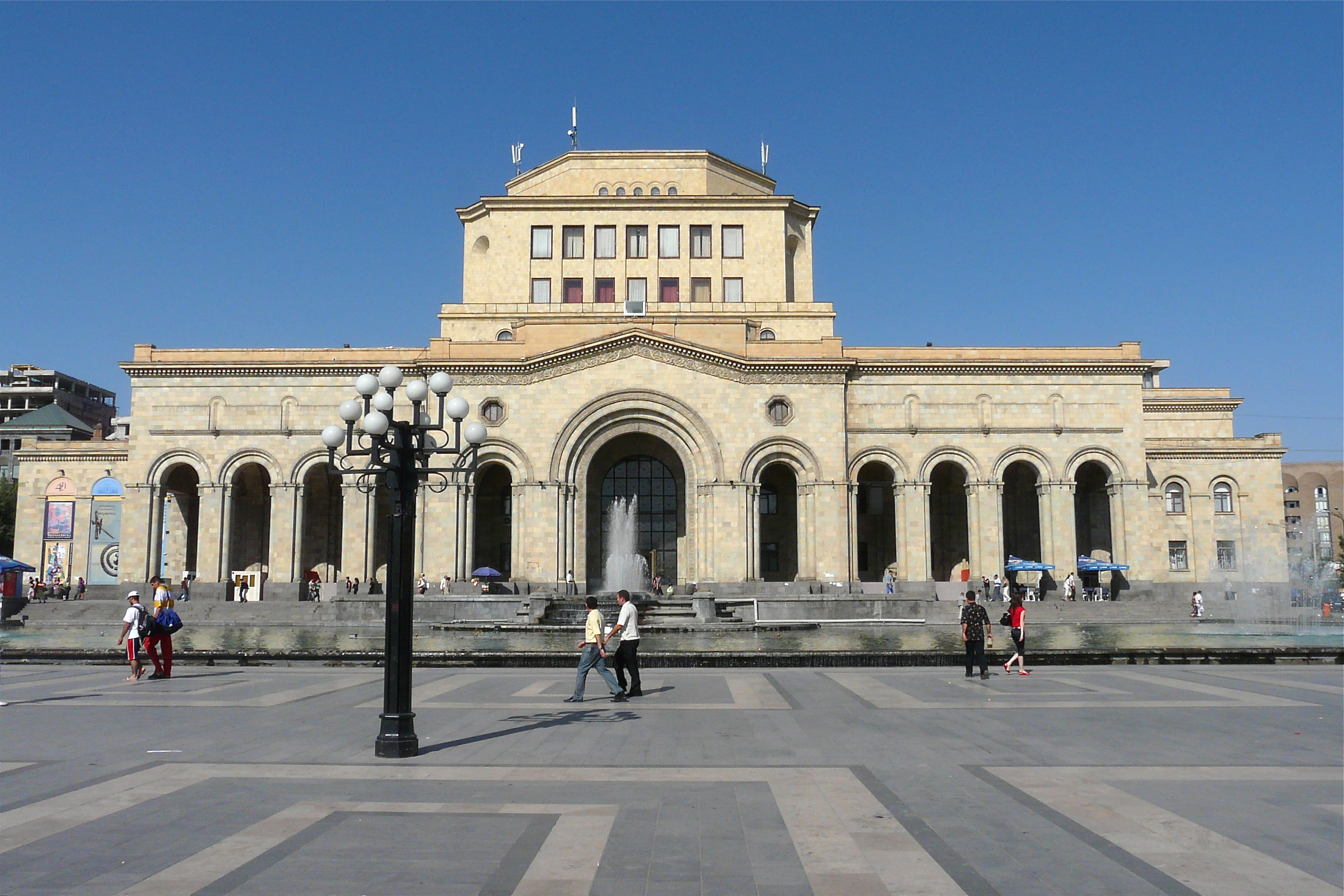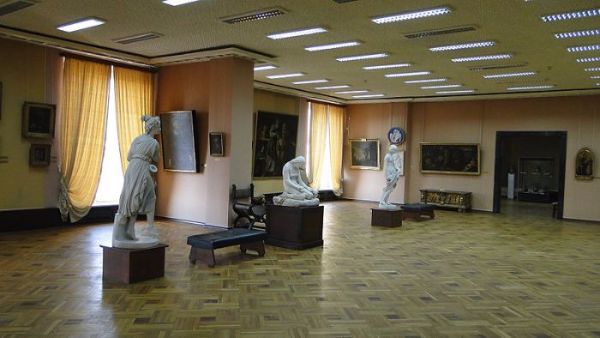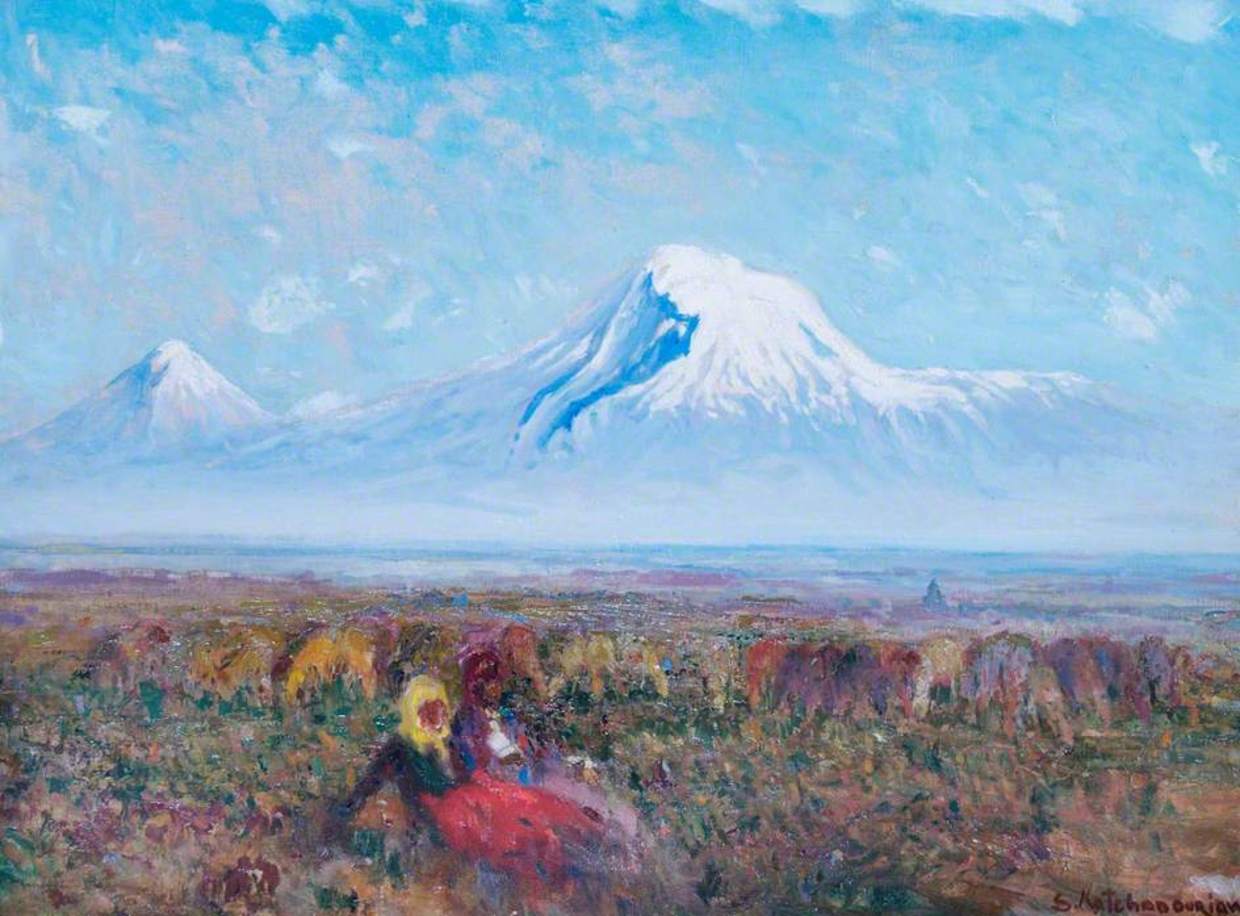Return
Useful address » Entertainment
|
Ref ID: 3EA2016/405 | Posted On: 08-09-2016 | Updated on: 08-09-2016
|
|
Director +374-10-580812
Opening time
Sunday 11:00-17:00 (Last admission 16:15)
Monday Closed
1921-1935 Art Department of the State Museum
The National Gallery of Armenia was founded in 1921 by the decision of the Soviet Armenian Government, as the Art Department, one of the five departments of the State Museum. Martiros Sarian was appointed the Director of the museum, while Vrtanes Akhikian was named head of the Department of Arts. The State Museum was then located on Astafian (Abovyan) street, in the two-storey tufa building of boys’ gymnasium (architect V. Simonson).The museum building also housed the public library and concert hall. The building also served as a shelter for the orphans who emigrated from Western Armenia. For this reason, the museum did not hold exhibitions for the first four years after it was opened. Due to the lack of exhibitions, upon his visit to Armenia in 1924 A. Lunacharsky voiced his displeasure with the museum, comparing it with a big motley storeroom.
As evidenced by a list of invitees to the opening ceremony of the “Museum of Art” on August 14, 1921, the range of participants at this event was diverse. Among the attendees were painters, actors, musicians, officials, workers, soldiers, pupils, and students. The first visitors included famous artists Karo Halabian, Sargis Khachatrian, Taragros, Romanos Melikian and others. The opening ceremony attracted 130 people.
The first group of several dozen works was purchased by the Government for the museum in July of 1921 from the 5th exhibition of the “Union of Armenian Artists”. This exhibition was organized in the Central Club of Workers named after S. Shahumian. The works included those of famous painters Y. Tadevosian, S. Arakelian, H. Hagopian, V. Akhikian, G. Sharbabchian, the graphic artist E. Chahine, and many others.
In September of the same year, by the decree of Moscow’s All-Russian Central Executive Committee, the former Lazarev Institute was renamed Culture House of Soviet Armenia. At this moment, its material and cultural values passed into state ownership of Armenia. This decision played a decisive role in the formation of museum’s collection, since all of the Russian and European artworks were acquired by the Armenian Museum. This emphasized the collecting practices of the museum - to accumulate works of international fine arts and decorative applied art.
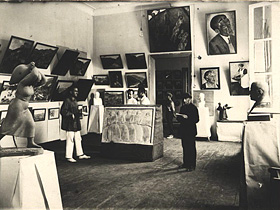
400 works by Armenian, Russian and European artists were certified in the “Brief list” of the Department of Fine Arts of the State Museum, published in Yerevan in 1925.Those works were exhibited in six halls. This was the first brief reference book of the museum, which in addition to other data, also included names of benefactors such as Moscow-resident, architect and engineer Hakob Ekizler (Ekizian). His donations of the works of Hovh. Aivazovsky, V. Sureniants, S. Shchedrin, I. Shishkin, V. Polenov, V. Makovsky and others are among the masterpieces of the gallery.
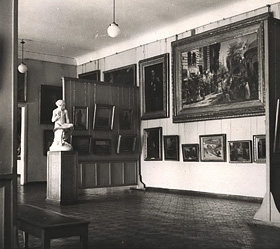 Generally, every museum has a unique history of its foundation. As for the State Museum, donations have played a significant role in the history of the gallery. Having a narrow escape from the Genocide, Armenian people had to leave the land of their ancestors to find shelter in the Near East, Europe and the USA. They took these countries as their second homeland, formed national communities and got engaged in the political, economic and social life of their new environment. They also got involved in cultural activity that included all the spheres of spiritual life: literature, music, and fine arts. Nevertheless, these people longed for their homeland, and remained connected with its problems and achievements. Therefore, it was quite reasonable that Armenian artists got engaged in the cultural life of reviving Armenia, especially in the foundation of the art museum.
Generally, every museum has a unique history of its foundation. As for the State Museum, donations have played a significant role in the history of the gallery. Having a narrow escape from the Genocide, Armenian people had to leave the land of their ancestors to find shelter in the Near East, Europe and the USA. They took these countries as their second homeland, formed national communities and got engaged in the political, economic and social life of their new environment. They also got involved in cultural activity that included all the spheres of spiritual life: literature, music, and fine arts. Nevertheless, these people longed for their homeland, and remained connected with its problems and achievements. Therefore, it was quite reasonable that Armenian artists got engaged in the cultural life of reviving Armenia, especially in the foundation of the art museum.
In 1923 the People’s Commissar of Education Askanaz Mravian turned to the French-Armenian painters, asking them to help the museum to the best of their ability. His call for help received an enthusiastic response from V. Mahokian, Z. Zardarian, T. Yesayan, S. Khachatrian, R. Chichmanian and others, who by 1935 had donated a total of 40 works to the museum. Among grantor-benefactors of the first decade of the museum’s activity were painters M. Sarian, Y. Tadevosian, P. Terlemezian, V. Gayfejian, collectors V. Vahanian, D. Khan-Kelekian, V. Kananian. Donations also included the works of renowned Russian painters Al. Benois, A. Ostroumova-Lebedeva, Y. Lansere, who granted their own works to the gallery. Later on, thanks to Isaac Brodsky’s donation to the museum, the collection of Russian art was enriched with the works of world-famous 20th century artists K. Juon, B. Grigoriev, B. Anisfeld and F. Malyavin.
1935-1947 The State Fine Art Museum
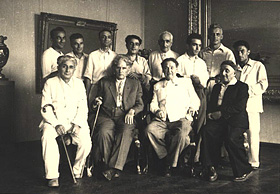 At the end of 1924, by the request of Al. Tamanian and M. Sarian, art historian Ruben Drambian moved from Leningrad to Yerevan. Quitting his work in the State Russian Museum, in 1925, Drambian shouldered the responsibilities of the Head of the Department of Fine Arts, and in 1935, when the substantially enriched and expanded department grew into an independent State Museum of Fine Arts, Drambian became its first director, serving in this post until 1951. His professional intuition, talent for accumulating collection items and museum work experience predetermined the future course of development of the gallery. Thanks to the well-planned and systematized distribution of collections (purchases from republican exhibitions, studios, private individuals, allocations from museum funds of Russia, the State Hermitage, the State Russian Museum, national collections) as well as continuous donations, the Museum of Fine Arts quickly won the fame of one of the best museums in the Soviet Union. At this stage research became an indispensable part of museum activity.Under the supervision of L. Durnovo, art historian and connoisseur of ancient art invited from Moscow (1882-1963), the museum initiated research and replication of medieval Armenian frescoes and miniatures.The team of young artists, including Y. Khachatrian, M. Chubarian, R. Loris-Melikov, V. Baghdasarian, G. Khanaghian, H. Gharagyozian, studied the specialized professions of reproduction and restoration. During expeditions in different regions of Armenia the team discovered, investigated, dated and reproduced the works of Armenian monumental painting.
At the end of 1924, by the request of Al. Tamanian and M. Sarian, art historian Ruben Drambian moved from Leningrad to Yerevan. Quitting his work in the State Russian Museum, in 1925, Drambian shouldered the responsibilities of the Head of the Department of Fine Arts, and in 1935, when the substantially enriched and expanded department grew into an independent State Museum of Fine Arts, Drambian became its first director, serving in this post until 1951. His professional intuition, talent for accumulating collection items and museum work experience predetermined the future course of development of the gallery. Thanks to the well-planned and systematized distribution of collections (purchases from republican exhibitions, studios, private individuals, allocations from museum funds of Russia, the State Hermitage, the State Russian Museum, national collections) as well as continuous donations, the Museum of Fine Arts quickly won the fame of one of the best museums in the Soviet Union. At this stage research became an indispensable part of museum activity.Under the supervision of L. Durnovo, art historian and connoisseur of ancient art invited from Moscow (1882-1963), the museum initiated research and replication of medieval Armenian frescoes and miniatures.The team of young artists, including Y. Khachatrian, M. Chubarian, R. Loris-Melikov, V. Baghdasarian, G. Khanaghian, H. Gharagyozian, studied the specialized professions of reproduction and restoration. During expeditions in different regions of Armenia the team discovered, investigated, dated and reproduced the works of Armenian monumental painting.
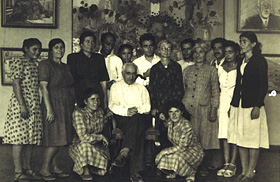 Many of the frescoes that ornamented the ruined churches left to the mercy of fate no longer exist, and as a result their replications have acquired the value of original works. Owing to L. Durnovo and the team of Armenian young artists, the visitors of the National Gallery of Armenia can today admire the frescoes of Arutchavank, Lmbatavank, the Monastery of Tatev, and many other churches. It is noteworthy that later the collection was greatly enhanced by the additional new reproductionser. By 1985 made it was possible to exhibit these frescoes, as well as the replications of miniatures and high relief church sculptures in special rooms of the new gallery building. The medieval art exposition shows the chronological sequence of Armenian fine arts, from the early Middle Ages to 17-18th century church painting, followed by modern and contemporary art. From 1930-1950, the museum collection was regularly enriched, giving rise to temporary exhibitions, brief catalogues and booklets. Armenian, Russian and Western European art was presented in three sections of permanent exhibition. The work was administered by respective research departments.
Many of the frescoes that ornamented the ruined churches left to the mercy of fate no longer exist, and as a result their replications have acquired the value of original works. Owing to L. Durnovo and the team of Armenian young artists, the visitors of the National Gallery of Armenia can today admire the frescoes of Arutchavank, Lmbatavank, the Monastery of Tatev, and many other churches. It is noteworthy that later the collection was greatly enhanced by the additional new reproductionser. By 1985 made it was possible to exhibit these frescoes, as well as the replications of miniatures and high relief church sculptures in special rooms of the new gallery building. The medieval art exposition shows the chronological sequence of Armenian fine arts, from the early Middle Ages to 17-18th century church painting, followed by modern and contemporary art. From 1930-1950, the museum collection was regularly enriched, giving rise to temporary exhibitions, brief catalogues and booklets. Armenian, Russian and Western European art was presented in three sections of permanent exhibition. The work was administered by respective research departments.
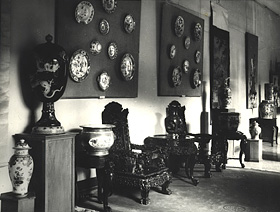 The above-mentioned period was remarkable for the museum as its collection was enriched by the donations of three prominent collectors. Romanian-Armenian art historian G. Zambakhchian consigned to the museum a number of valuable paintings by Th. Rousseau, Díaz de la Peña, A. Monticelli, E. Boudin, A. Bénard, and others, which imparted a new quality to the collection of French painting. The large collection of another Romanian-Armenian collector Vahan Barakian, donated to the museum, was comprised of paintings and graphic works by prominent Romanian painters, European engravings, as well as 150 pieces of decorative applied art (representing the art of Europe, Russia, and the East). In 1936 the renowned Armenian graphic artist Edgar Chahine, who enjoyed wide recognition in France, increased the number of his works in the museum by 170 engravings, which he sent from Paris for his private exhibition in Yerevan. Thirty paintings and nine drawings were added to the collection of world-known marine artist Hovh. Aivazovsky by his sincere admirer Abraham Zintchian (France). One of the major events in the life of the museum was associated with Aivazovsky’s name. At the time of the Great Patriotic War the museum continued working in full force. Moreover, ensuring the security of its collections, it even provided room for the precious collection and archive of the Aivazovsky Picture Gallery, evacuated from Theodosia. Since November 8, 1941, the collection was kept in the Museum of Fine Arts. On May 2, 1942 it was exhibited, jointly organized by the administration of the museum and the Artists’ Union of Armenia on the occasion of the Aivazovsky’s 125th anniversary. The exhibition was held in the Persian Mosque which then hosted the Artists’ Union then. The exhibition housed fifty-seven seascapes by Aivazovsky, as well as the works of ten different Western European painters. The opening ceremony attracted Martiros Sarian, Head of Cultural Affairs Department A. Shahinian, Academic J. Orbeli, the Director of the Museum R. Drambian and the Director of the Aivazovsky Picture Gallery of Theodosia N. Barsamov. In only twelve days an astounding number of 45000 people visited the exhibition. On November 5, 1944 the paintings were all returned to the Theodosia Picture Gallery in Crimea.
The above-mentioned period was remarkable for the museum as its collection was enriched by the donations of three prominent collectors. Romanian-Armenian art historian G. Zambakhchian consigned to the museum a number of valuable paintings by Th. Rousseau, Díaz de la Peña, A. Monticelli, E. Boudin, A. Bénard, and others, which imparted a new quality to the collection of French painting. The large collection of another Romanian-Armenian collector Vahan Barakian, donated to the museum, was comprised of paintings and graphic works by prominent Romanian painters, European engravings, as well as 150 pieces of decorative applied art (representing the art of Europe, Russia, and the East). In 1936 the renowned Armenian graphic artist Edgar Chahine, who enjoyed wide recognition in France, increased the number of his works in the museum by 170 engravings, which he sent from Paris for his private exhibition in Yerevan. Thirty paintings and nine drawings were added to the collection of world-known marine artist Hovh. Aivazovsky by his sincere admirer Abraham Zintchian (France). One of the major events in the life of the museum was associated with Aivazovsky’s name. At the time of the Great Patriotic War the museum continued working in full force. Moreover, ensuring the security of its collections, it even provided room for the precious collection and archive of the Aivazovsky Picture Gallery, evacuated from Theodosia. Since November 8, 1941, the collection was kept in the Museum of Fine Arts. On May 2, 1942 it was exhibited, jointly organized by the administration of the museum and the Artists’ Union of Armenia on the occasion of the Aivazovsky’s 125th anniversary. The exhibition was held in the Persian Mosque which then hosted the Artists’ Union then. The exhibition housed fifty-seven seascapes by Aivazovsky, as well as the works of ten different Western European painters. The opening ceremony attracted Martiros Sarian, Head of Cultural Affairs Department A. Shahinian, Academic J. Orbeli, the Director of the Museum R. Drambian and the Director of the Aivazovsky Picture Gallery of Theodosia N. Barsamov. In only twelve days an astounding number of 45000 people visited the exhibition. On November 5, 1944 the paintings were all returned to the Theodosia Picture Gallery in Crimea.
1947-1991 The State Gallery of Armenia
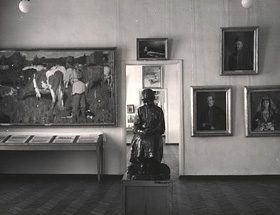 In 1947 the museum was renamed the “State Gallery of Armenia” until 1991, when it was again renamed the “National Gallery of Armenia”. The year 1948 marked the beginning of reconstruction of the museum building.
In 1947 the museum was renamed the “State Gallery of Armenia” until 1991, when it was again renamed the “National Gallery of Armenia”. The year 1948 marked the beginning of reconstruction of the museum building.
Little by little the gallery expanded its scope of activity. For instance, in 1948, partnership with the Art Sector of the Academy of Sciences of Armenia two works – “The Miniatures of Armenia” and “Armenian Art of the 19-20th Centuries”, – were prepared for publication.
In 1951, after 27 years of running the gallery, R. Drambyan left his post as Director, but his cooperation with the gallery continued for years (he was a member of the Scientific Council, an irreplaceable advisor, and in 1982 published his book “The State Gallery of Armenia” in Russian). For only a year the gallery was administered by art historian Vahan Harutyunian and in 1952-1962 – by Ruben Parsamyan.
In this period the gallery continued its activity a steady direction, proceeding with the investigation and expansion of the collections, organization of private exhibitions of Armenian artists, and the opening of the Department of Manuscripts and Documentation Fund headed by Daniel Dznuni. The latter was assigned to prepare the “Dictionary of Armenian Art Historians” for publication (issued in 1977) and the album “The State Gallery of Armenia”, whose introduction was written by R. Drambyan (1956). On the basis of existing collections new research departments were created. For this purpose, graduates of the I. Repin Leningrad Art Institute were recruited to staff the research department of the gallery. The successful generation change ensured future development of the research activity of the museum.
In 1946 Yerevan welcomed the distinguished artist Bedros (Bedo) Kontradjian from Paris, who donated fifty paintings and about 600 graphic works to the museum. In 1958 another French-Armenian compatriot Hakob Arakelian organized the accumulation of famed sculptor Hakop Gurdjian’s artistic heritage, including busts, compositions, graphic works and important archive material. The total number of works altogethercomprising to 400 pieces, was transferred to the gallery. In 1959 the museum staged an exhibition of the sculptor’s works, which found a warm response in public, especially among young sculptors.
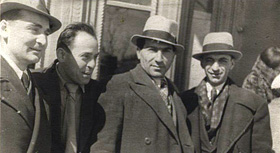 In 1962 the painter and stage designer Armen Chilingarian was appointed Director of the gallery after the acting Director Ruben Parsamian left the position to take up another post. In the years of his administration, the museum collections were considerably enriched on the initiative of the art historian of the Department of Russian and West-European Art Mary Sargsian. In this period the gallery acquired invaluable works by well-known 20th century well-known Russian painters R. Falk, P. Filonov, I. Mashkov, A. Kariov, N. Altman and others. 17-18th century Russian icons were sent from the the museums of Kremlin, Moscow. In 1965 the first private exhibition of Robert Falk’s works was staged, with the assistance of his widow A. Shchekin-Krotovo. The exhibition was an unprecedented phenomenon in those years, as the painter had been disgraced for political reasons. This exhibition of Falk’s works was followed by another one in Novosibirsk, and later in Moscow. The gallery purchased over a dozen works from this exhibition, and another three were gifted to the museum by the painter’s widow.
In 1962 the painter and stage designer Armen Chilingarian was appointed Director of the gallery after the acting Director Ruben Parsamian left the position to take up another post. In the years of his administration, the museum collections were considerably enriched on the initiative of the art historian of the Department of Russian and West-European Art Mary Sargsian. In this period the gallery acquired invaluable works by well-known 20th century well-known Russian painters R. Falk, P. Filonov, I. Mashkov, A. Kariov, N. Altman and others. 17-18th century Russian icons were sent from the the museums of Kremlin, Moscow. In 1965 the first private exhibition of Robert Falk’s works was staged, with the assistance of his widow A. Shchekin-Krotovo. The exhibition was an unprecedented phenomenon in those years, as the painter had been disgraced for political reasons. This exhibition of Falk’s works was followed by another one in Novosibirsk, and later in Moscow. The gallery purchased over a dozen works from this exhibition, and another three were gifted to the museum by the painter’s widow.
A year later, thanks to dynamic negotiations, Yerevan hosted another significant exhibition – Pablo Picasso’s graphic works from Ilya Ehrenburg’s collection.
The 1960s were especially fruitful for the enrichment of the museum collection. Aghasi and AzganushDarbinian from Paris donated 70 illustrations of La Fontaine’s fables, drawn by T. Polad, as well as 25 etchings by E. Chahine to the gallery. They also organized the transfer of over 100 works of O.Alhazian artistic heritage to the gallery. Upon his visit in Yerevan to stage a private exhibition, celebrated American artist Rockwell Kent donated 14 of his paintings to the gallery. French-Armenian sculptor Daria Kamsarakan presented two sculptures made of marble and bronze. Following the exhibition of contemporary French-Armenian painters held by the French-Armenian Cultural Union, sixty-three of the exhibited works were sent to Armenia as a donation.Lebanese-Armenian artists also donated their axhibited works to the gallery. Invaluable were works by Italian-Armenian sculptor Nvard Zarian -twenty-three of her works have found their unique place in the Gallery’s collection of sculptures.
There were of corse far more donations than those mentioned.Taking into account the acquisition of Soviet Armenian artists’ works from private and republican exhibitions and the transfers from the collections of the Ministry of Culture, one gets a better idea of the whole acquisition process.
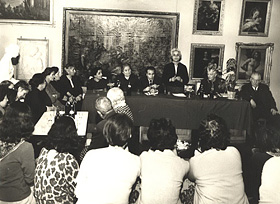 In 1963 by the decision of the research council of the gallery, V. Baghdasarian and H.Siravian undertook the restoration of the curtain of G. Sundukian National Academic Theatre (originally designed by Martiros Sarian) Its installment in a special hall of the gallery earned the great painter’s praise.
In 1963 by the decision of the research council of the gallery, V. Baghdasarian and H.Siravian undertook the restoration of the curtain of G. Sundukian National Academic Theatre (originally designed by Martiros Sarian) Its installment in a special hall of the gallery earned the great painter’s praise.
In 1967-1986 the gallery was run by people’s artist Edward IsabekIan. The first years of his activity coincided with the construction of the new building for exhibitions (designed by architects M. Grigorian, A. Ghazarian).
In 1977 the museum was reopened with a new display of its collections. A few years later the building on Nalbandyan Street was put into use. The four floors of the building housed the collection repositories, restoration studio, research departments, and the department of inventory and conservation. Also opened the the research departments of sculpture, decorative-applied art and the department of branch management. This department coordinated the work of its satellite museums running in different regions of the republic, namely Etchmiadzin, Hrazdan, Jermuk, Martuni, Leninakan, Kirovakan, as well as the exhibition halls in Alaverdi and Yeghegnadzor. 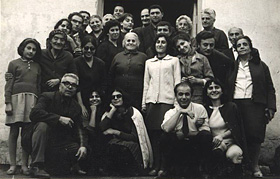 The main objective of the branches was to satisfy the artistic need of the population living far from the cultural centers of the capital. A collection of works of Armenian artists’ was selected from the museum collections to be displayed as a permanent exhibition in the new building. It also hosted regular thematic exhibitions and private exhibitions of local painters.
The main objective of the branches was to satisfy the artistic need of the population living far from the cultural centers of the capital. A collection of works of Armenian artists’ was selected from the museum collections to be displayed as a permanent exhibition in the new building. It also hosted regular thematic exhibitions and private exhibitions of local painters.
In 1972, Director of “Georgy Yakoulov’s Friends’ Club” in Paris, painter Rafael Kherumian addressed a letter to the Armenian Government expressing willingness to pass the paintings and graphic works of renowned artist Georgi Yakoulov to Armenia. The responsibility of transferring Yakoulov’s works from Paris to Yerevan was assigned to the gallery. Apart from expanding the gallery’s collection, the donations significantly increased Armenian fine arts collection of the early 20th century. Soon after, the artist’s retrospective exhibition was held, with the participation of various museums of the Soviet Union. The exhibition was then taken to Moscow to be displayed in the State Museum of Eastern Art.
At the same time the State Gallery of Armenia furthered its ties with the Moscow and Leningrad museums in the spheres of research and exhibition work. The Hermitage compiled and held a memorable exhibition of the canvases of the French impressionists from its collection. The paintings of W. Kandinsky and M. Chagall represented the State Gallery of Armenia in joint international exhibitions. Representatives of the gallery were regular participants at the annual symposiums of the International Council of Museums.
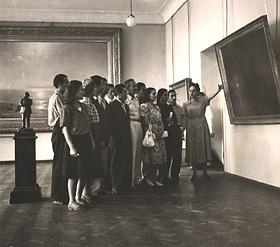 Under E. Isabekyan’s administration the gallery reported considerable progress. This was in part, due to the awareness of the importance to develop museum specialists, as well as desire to purposefully expand, properly conserve and thoroughly investigate the existing collections.
Under E. Isabekyan’s administration the gallery reported considerable progress. This was in part, due to the awareness of the importance to develop museum specialists, as well as desire to purposefully expand, properly conserve and thoroughly investigate the existing collections.
Experienced senior registrar Yevgenya Khachatrian was replaced by Alis Bakrajian, who had already successfully inherited her forerunner’s experience, devotion and long years of museum service. A number of young painters assembled around the only qualified painter-restorer in Armenia, Vardges Baghdasarian apprentice to L. Durnovo, Head of the Restoration Studio.Baghdasarian tutored them, and with great devotion passed on his experience and professional secrets to them. Acquiring skills, mastery and qualification in the advanced training courses at the museums of Moscow, Leningrad, and I. Grabar Scientific Restoration Center, these young specialists shouldered the significant responsibility of restoring and conserving the museum objects.
Another is another remarkable event of this period, decided by the scientific council of the gallery, was a documentary reproduction of the fresco on Kobayr Monastery (12-13th century). It found its place in the permanent exhibition of the museum. Further, the Armenian expedition successfully accomplished the replication of the central apses of St. Stephen church (15th century) in Theodosia and the Holy Cross Monastery (1338) in Crimea.
The heads of the gallery branches and guides were retrained in the State Hermitage and the State Russian Museum. Each year the above-mentioned museums, especially the Hermitage, hosted museum researchers working in the areas of Russian and European painting, graphic and applied art. The collaboration with prominent Russian art historians made it possible to decipher the works of certain artists and schools in the Gallery’s collection.
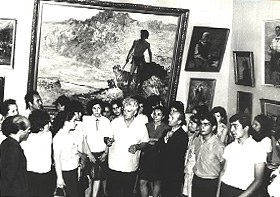 This period is also prominent for the publication of a number of album-catalogues, namely, “Hakob Hovnatanian and his Predecessors”, “Sargis Khachatrian”, “Yeghishe Tadevosian”, “Vano Khojabekian”, “Sedrak Rashmajian”, “Sedrak Arakelian”, “Edgar Chahine” and others. Thanks to continued donations the Gallery’s collections further expanded. The renewed momentum of these donations recalled the enthusiasm of the Diaspora’s Armenians at the time of the Gallery’s foundation between 1920-1930.
This period is also prominent for the publication of a number of album-catalogues, namely, “Hakob Hovnatanian and his Predecessors”, “Sargis Khachatrian”, “Yeghishe Tadevosian”, “Vano Khojabekian”, “Sedrak Rashmajian”, “Sedrak Arakelian”, “Edgar Chahine” and others. Thanks to continued donations the Gallery’s collections further expanded. The renewed momentum of these donations recalled the enthusiasm of the Diaspora’s Armenians at the time of the Gallery’s foundation between 1920-1930.
The European art collection was enriched by the acquisition of “Portrait of Gajzágó Salomon” painted by the Hungarian artist Ignacz Roskovics and donated to the gallery by the Armenian Society of Hungary. The portrait is now displayed in the permanent exhibition of the gallery. Famous writer and dramatist Gajzágó was an Armenian by origin, whose ancestors had moved to Hungary in 1672. He was one of the organizers of the battle for the liberation of the Hungarian people in the 19th century.
Another contribution to the museum collection were the donations of the painter Rafael Kherumian from Paris. He presented the canvases “Portrait of a Man” by an English artist Marcus Gerards and “Portrait of a Man” attributed to the Spanish painter Francisco de Goya. The US Union of All-Sebastia-Armenians donated “The Anointing of David” painted by Antonio Molinari, an artist belonging to the Venetian school. The subject is taken from the Old Testament and the painting was completed by the end of the 17th and beginning of the 18th centuries. Another one of his contributions was the marble artwork “Bust of Caesar” sculpted by Italian sculptor G. Biagiotti. Sculptor Khoren Der-Harootian entrusted Auguste Rodin’s drawing “The Model” to the gallery. Meanwhile, French-Armenian Albert Ashchian gifted three paintings by the contemporary Spanish artist Juan Ripolles.
In the 1970’s donations also triggered the expansion of the Russian art collection. Thus, Zagorsk (an archive of artworks) contributed graphic works of 20th century prominent Russian painters M. Le-Dantu, L. Bakst, O. Rozanova, V. Konashevich, and others to the museum collection. The All-Union Center of Productive Painting donated nine sculptors by renowned sculptress Sara Lebedeva and a number of paintings by V. Rozhdestvensky, V. Stozharsky, S. Savitskas, and others.
Donations also included the works of Armenian artists. Collector Aghasi Darbinian (Paris) gifted a pastel by the great engraver Tigran Polad. Painter R. Jeranian (Paris) presented fourteen etchings by the same author. Jansem sent thirty of his engravings and drawings, while Carzou gave 118 lithographs. Vardush Muradian, Arshile Gorky’s sister, entrusted the renowned artist’s drawing “Seated Woman” to the gallery.
In 1975 the “Aurora” publishing house issued the comprehensive album “The Art Gallery of Armenia” compiled by N. Mazmanian (in English and French).
In the 1980’s a number of jubilee exhibitions were held, namely those of Hakob Gyurjian, Sedrak Rashmajian, Sedrak Arakelian, Hakob Kojoyan, Georgi Yakoulov. All exhibitions yielded printed catalogues.
Thanks to the large-scale exhibitions organized in different cities of the USSR, Armenian artists gained wide recognition. Tbilisi, for instance, hosted an exhibition of Gevorg Bashinjaghian’s works, while Kaunas welcomed Sedrak Arakelian. Makhachkala was exposed to Armenian painting and applied art, Lvov learnt about the 18-20th century Armenian art, weaving, and silver art, while Kiev was granted an opportunity to enjoy the 19-20th century Russian painting through the Gallery’s collection.
In May of 1986 Edward Isabekian left his post of the Director, terminating his nineteen year persistent service in this cultural center. In July of the same year the office was assumed by Alexander Ter-Gabrielian, who for years had worked as Head of the Art Department of the Armenian SSR Ministry of Culture, and was well aware of the gallery’s activity.
In the time of Soviet rule, the gallery was included in the All-Union cultural system, which ensured its participation in the conferences and preparation courses, organized throughout the country. As a member of the Soviet Division of the International Council of Museums (ICOM), representatives of the State Gallery were usual invitees to the sittings held in the capitals or major cities of different Soviet republics – Moscow, Lvov, Alma-Ata, Vladimir, Vilnius, etc. These meetings reinforced the ties between different museums within the Soviet Union. On the initiative of the Hermitage the Armenian public was due to enjoy the exhibitions “Western European Engraving of the 18th Century” and “Western European Landscape of the 19th Century”. On the occasion of the RSFSR cultural days in Armenia, the exhibition “Russian Soviet Landscape” was staged in the State Russian Museum of Leningrad. The retrospective exhibition highlighting the culture and art in the Armenian SSR was organized in Moscow. The gallery also organized exhibitions of its collection in Sochi, Alma-Ata, and Izmail.
1991-2011 The National Gallery of Armenia
In 1991, the Republic of Armenia entered a new historical and political stage: the country declared independence. This event was significant because independence was something that the Armenian people had been fighting towards for centuries. But this decisive victory was accompanied by a number of problems forced by the newly formed republic, activities of which were reflected in the cultural life.The country entered a serious political, socio-economic, and cultural crisis. Along with the scientific and cultural establishments, the State Gallery of Armenia also had to bear many hardships during that time.
In 1991, the art historian Shahen Khachatrian was appointed the director of the Gallery. A person devoted to Armenian culture, previously collaborated with the Department of Armenian Fine Arts of the SGA, and since 1967 he had served the Director of the Martiros Sarian Museum. In 1991, Armenia’s largest artistic institution was renamed the National Gallery of Armenia (NGA).
In the same year, the Ministry of Culture of RA confirmed a new statute of the NGA. By uniting former Armenian old and medieval, new and modern art departments, one joint department of Armenian painting was established. Foreign and Russian painting departments were also created, becoming the Department of Foreign Painting.
Generally, the 1990’s were difficult times for the Gallery. Researchers did not have the opportunity to participate in conferences and training courses held in the former USSR’s largest maintaining centers. The connections with foreign museums and cultural establishments became difficult. However, even in difficult conditions, the staff of the National Gallery continued to carry out their duties. In 1992, the Gallery presented visitors with newly permanent and altered exhibitions, and during 1991-2000, about 130 exhibitions were organized. The museum’s various collections were presented, as well as personal exhibitions of differing contemporary artists. It is worth mentioning the highly successful exhibitions: “Three Coloured Worlds” (Martiros Sarian, Haroutiun Galentz and Minas Avetisian), as well as “Sea Song” held in Marseille (Hovhannes Aivazovsky and his followers).In this period of time when the obstacle of the “Iron Curtain” disappeared, the role of Diaspora’s Armenians in the NGA increased. The Gallery collection - the major part of which was created by means of donations – was continuously expanding, primarily because of the Armenians from the Diaspora.It was in those years that the National Gallery and the newly created “Sargis Khachents” publishing house began producing art literature that was translated from the originals into Armenian. The Gallery’s first trilingual guide was also published in France, as well as the albums of “Armenian Artists of the 19th-20th Centuries” and “Christian Armenia-1700”.
In 2002, painter and professor, Paravon Mirzoyan, was appointed the Director of the NGA. Under his supervision the Gallery’s research funds and educational departments flourished, giving the Gallery a new impact and field of opportunities. In the same year, the Ministry of Culture of RA issued an order stating that the “National Gallery of Armenia” was to be reorganized into a non-profit organization.
On May 18, 2004, after the reconstruction supported by the Lincy Foundation, the National Gallery of Armenia installed new permanent exhibitions and opened its doors to visitors. Since the reopening the Gallery has been leading an abundant working life - according to the principles of academic museum activity. That is to say to, collect, maintain, study and popularize artistic values by means of exhibitions and catalogues.
In recent years, the museum’s permanent exhibition was enriched by new decorative-applied arts of Ancient Greece and Ancient Egypt, graphic works of Edgar Chahine, new departments of Eastern arts (China, Japan, Iran and India), West European clocks from the 18-20th centuries, and sculptures by Hakob Gyurjian’s art works. In 2004, the Department of Public Relations was opened, and since 2008, in addition to its customary routine, it has also presented research and educational activities to the public. There are many programs taking place inside the NGA in order to ensure that the museum is actively involving the youth. Since 2009, enthusiastic volunteers from differing local universities have been working at the NGA, bringing considerable results to the gallery.
During these years the Gallery organized around 230 exhibitions in Armenia and abroad. As a whole, because exhibition activity has always been the core activity of scientific occupations that have been applied by the National Gallery – the NGA has been able to create larger volumes of work that can be presented at a greater scale, thus preserving rich collections and organizing different exhibitions of celebrated painters.
A few exhibitions that were favored by the people were both the 125th anniversary of Georgi Yakoulov and the 150th anniversary of Vardges Sureniants. Presenting Armenian classical fine arts to foreign audiences is regularly undertaken by means of various international exhibitions. Exhibitions of international artists’ works have become more frequent. One of the most successful, perhaps, is considered the exhibition “Dali and the Surrealists” organized in 2011 by the Ministry of Culture of RA, which caused an exceptional response and interest among local Armenian art enthusiasts.
In the last decade the publishing activity has greatly expanded. Each exhibition is the result of a research study of the presented collection, followed by the publishing of albums and catalogues. The NGA also plans on creating online catalogues, as well as publishing annual journals, where the studies by the Research -educational and Public Relations departments of the Gallery will be published.It is worth mentioning a few works the NGA has published: “The National Gallery of Armenia” (2008), albums of “Vardges Sureniants” (2010) and “Georgi Yakoulov” (2011) and monography of “Georgi Yakoulov” (2011).
The museum expands its collection not only through public or private purchases, but also through donations, which has become the traditional custom of the NGA.
Since 2005, the annual “National Gallery” classical music festival has been organized in the museum, bringing together music and fine arts in the Frescoes hall of the Gallery. It is already the seventh year that the synthesis of art and music has been accessible to the Armenian audience.
The National Gallery of Armenia participates in a number of international programs. Since 2005 “Museums Night” international project has been implemented, this is already famous and favoured in large spheres of the society, as well as “The European Heritage Days” annually organized events.
In partnership with foreign embassies in our Republic, other countries’ cultural days are regularly held in the National Gallery.
Looking back at the history of the National Gallery of Armenia for the past ninety years, the NGA has established many culturally diverse missions, utilizing the museum to its fullest capabilities and substantiating its honor. The National Gallery will doubtlessly continue its devoted work to its nation and continuously develop and enrich it with new art, activities, and culture.
Activities and Services
Activities
Activities in the Field of Museology and Protection of Cultural and Natural Heritage- Exposition of Sculptures
- Exposition of Works of Arts and Crafts
- Exposition of Works of Fine Arts
Services
Guided Tour- Armenian 3500 AMD
- Russian, English, Italian, French 5000 AMD
Entrance of the National Gallery of Armenia is free on last Saturdays of each month only for the citizens of Armenia.
Additional Information
Facilities
Contact information
Share information

